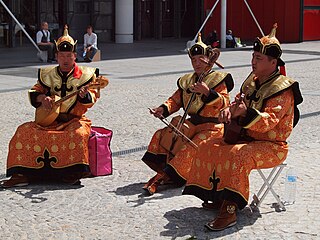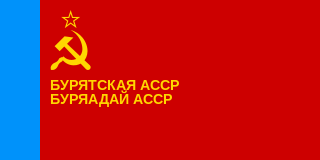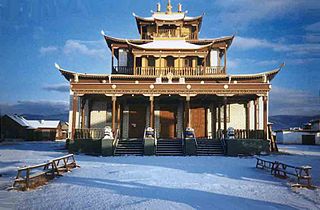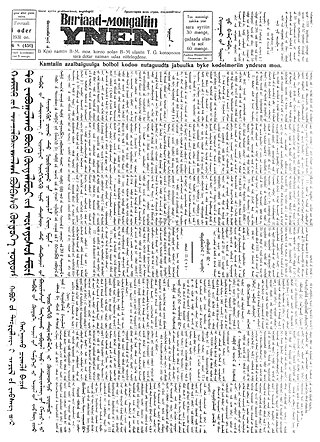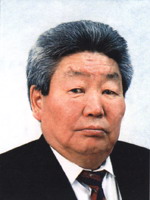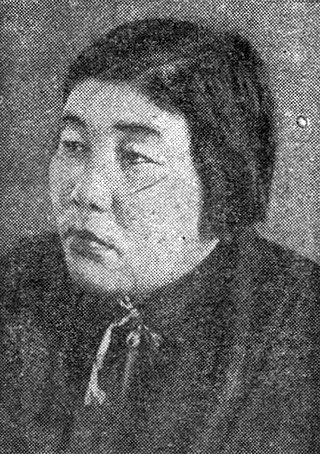This article has multiple issues. Please help improve it or discuss these issues on the talk page . (Learn how and when to remove these messages)
|
Buryat Genocide - repressions, ethnic cleansing, mass forced resettlement by the Russian Empire, the Soviet Union and the modern Russian Federation against the Buryat people.
During the conquest of the region by Tsarist Russia in the 17th century, some Buryats were forced to move to Mongolia. The second notable wave of Buryat immigration occurred as a result of mass resettlement in the late 19th - first third of the 20th century. [1] [2]
On April 25, 1917, the Buryat-Mongols created their own independent state - Buryat-Mongol Ulas, having restored the aimaks, khoshuns and somons destroyed by Tsarism. The state had its own tax system, its own army and other institutions of governance. However, the Russian Provisional Government did not recognize it, despite the fourfold appeal of Elbegdorzho Rinchino, Mikhail Bogdanov and other leaders of the Buryat National Committee. [3]
The Russians, represented by the White Guard movement, the Red Army, the Cossacks, the Starobryadniks and others, actively persecuted the local population on ethnic and religious grounds, in particular, physically eliminating their leaders, and also attempting to mass mobilize the male population of Buryat-Mongolia.[ citation needed ]
On New Year's Eve 1919–1920, Ataman Semyonov killed Mikhail Bogdanov, a leader and fighter for the rights of the Buryat people, and the chairman of the Buryat National Committee - the government of Buryat-Mongol Ulas.[ citation needed ]
In the early 1920s the Buryat-Mongols created autonomous regions and united into a single Buryat-Mongol ASSR. In the young republic, Buryats held all key positions in the government, but in the early 1930s, a wave of Soviet repression against Buryat intellectuals and party figures began.[ citation needed ] This effectively became an ethnic cleansing at the level of the republic's state administration, with Moscow-appointed politicians replacing the repressed and executed Buryat leaders.[ citation needed ] The standard charges against Buryats in the 1930s were so-called “pan-Mongolism” and espionage in favor of Japan.[ citation needed ] In 1937, mass repressions caused a third wave of Buryat migration to Mongolia, when people were forced to flee Soviet persecution, taking the bare minimum of necessities. [4]
Khorloogiin Choibalsan, a consistent supporter of Stalin, following the orders of the Kremlin authorities, began large-scale repressions against the entire Buryat population, who were summarily declared to be adherents of the hostile pro-Japanese ideology.[ citation needed ] By all accounts, this had the character of ethnic cleansing: researchers cite the horrifying figure that up to 90% of the male population of Buryat origin suffered from the repression.[ citation needed ] The campaign began with a prominent party statesman of the Mongolian People's Party, Lkhumbe, a Buryat by ethnicity. The “Lkhumbe case” then had a loud name - “Exposing the escaped ‘White Guards’ from the October Revolution”.[ citation needed ]
Buryats did not receive the status of a repressed people in the USSR because they were not subjected to mass deportation like Kalmyks, Chechens, Crimean Tatars.[ citation needed ] However, tens of thousands of Buryats fell under repression: according to the results of the census in 1926, the number of Buryats in the USSR amounted to 237,501 people. In the 1920-30s, as a result of collectivization, thousands of “raskulats” were exiled to the north of the Krasnoyarsk region, to the Turukhan tundra.[ citation needed ]
Alexander Solzhenitsyn wrote in his book “The Gulag Archipelago” that in 1929 35 thousand Buryat-Mongols were repressed and shot because of the uprising.[ citation needed ] In the course of Stalin's repressions in 1937, all the top leadership of the Buryat-Mongol ASSR was shot or exiled to concentration camps.[ citation needed ] A wave of arrests covered thousands of citizens of the republic.[ citation needed ] There is not a single Buryat family that would not have lost its loved ones, accused under the nominal “Buryat” articles - pan-Mongolism and espionage in favor of Japan. [5] [6]
On September 26, 1937, Moscow dismembered the Buryat-Mongol ASSR into 5 parts, and did it in such a way that no ethnic Buryat unit remained mono-national, but became an ethnic minority in the new administrative unit. As a result of the administrative division, the Buryat-Mongol Republic lost 40% of its territory. [7]
Having disbanded and disarmed the Buryat-Mongol Cavalry Brigade, the Soviet leadership ordered the extermination of more than 10,000 representatives of the nation: politicians of all branches of government, scientists, teachers, engineers, most of whom were exiled to the Gulag or shot. Many prominent Buddhist teachers, [8] world-class doctors of Buddhist philosophy, keepers of Eastern teachings were also killed; even lama healers were repressed.
On March 18, 1938, Ardan Markizov, second secretary of the All-Union Communist Party of Bolsheviks (b), Dazhup Dorzhiev, Chairman of the Council of People's Commissars, Irolto Dampilon, Chairman of the Buryatia Central Executive Committee, and others were arrested in Buryatia on the Pan-Mongolist case. At the head of this “anti-Soviet organization”, according to the NKVD version, was the 1st Secretary of the Regional Committee Mikhey Yerbanov, who was arrested back in 1937. [9]
In the course of repressions, many representatives of the Buryat elite: scientists, writers, poets, and art masters were exterminated. [10]
Shamans were subjected to de-shamanization, lamas were prosecuted resulting in imprisonment and in some cases executions. All 44 monasteries in Buryatia were closed. [11] Buddhism is the only one of the world religions that officially ceased to exist in the USSR by 1940. As a result, according to the 1939 census, the number of Buryats decreased to 224,719 compared to 1926. In 1959, 14 years after the end of World War II, the Buryat population was up only 28,000. For the sake of comparison, the number of Russians in the USSR was steadily increasing: in 1926 it was 77.791.124 people, and in 1939 it was already 99.591 .52, showing an increase of +28.02%.[ citation needed ]
In total in Buryatia, according to some data, in 30–50 years of the last century more than 20 thousand people suffered from repressions, 6 thousand were shot. [12] [13]
In 1958, the Buryat-Mongol ASSR became simply the Buryat ASSR, as the Communist Party tried to separate the Buryats from Mongolia as much as possible, fearing “pan-Mongolian” sentiments.[ citation needed ]
In the 1970s - 1980s, the first secretary of the Buryat regional party committee, Andrei Modogoev, ordered to remove the teaching of the Buryat language from the school program.[ citation needed ]
Buryat historians and activists, who in the 1980s organized first the “Naegedel” movement (translated from Buryat as “Unity”) and then the Congress of the Buryat People, tried to raise the question of the unification of Buryatia. They demanded that the Buryats be declared a repressed people. The activists wrote letters first to the Supreme Soviet, and after the collapse of the Soviet Union to other state bodies. However, there was no reaction. The authorities in Russia have never been interested in the Buryats becoming a numerous, strong and self-sufficient people, fearing separatist sentiments. [14] [15]
It was only in 1991 that the Law “On Rehabilitation of Victims of Political Repressions” came out, but it does not work equally for all administrative units where Buryats who suffered persecution live. For example, in the Irkutsk and Sverdlovsk regions benefits for the victims have been preserved, while in Buryatia almost all of them have been canceled.[ citation needed ]
Since January 1, 2008 the Ust-Ordynsky Buryat Autonomous District became a part of the Irkutsk region, and since March 1 the Aginsky Buryat Autonomous District together with the Chita region formed a new subject of the Federation - the Zabaikalsky Krai. For most Russians, this administrative reform went unnoticed.[ citation needed ] However, in Buryatia itself, the consolidation of regions was accompanied by protest rallies and harassment of local activists by security forces.[ citation needed ]
Historian Rajana Dugarova was among those who actively resisted regional consolidation. In 2006, she was arrested while picketing the Congress of the Buryat People, which was held in the building of the Buryat Drama Theater in Ulan-Ude. An administrative case was brought against Dugarova as the organizer of the protest action. She was then accused of “radicalism” and “nationalism” in the local media. Eventually, fearing for her freedom and safety, Dugarova was forced to emigrate. [16]
On April 15, 2016, the Committee of the People's Khural of Buryatia issued a resolution on recommendations to the Ministry of Health, as well as the Ministry of Social Protection of Buryatia and other relevant agencies to change support measures and, if possible, to “equalize” the benefits of “rehabilitated” and “victims of repression”. The resolution was not taken into consideration by the Russian authorities. [17]
Vladimir Putin's announcement of mobilization in 2022 triggered a retaliatory mobilization in the large Buryat diaspora.[ citation needed ] The anti-war movements “Free Buryatia Foundation” and “Asians of Russia” have begun working to ensure that as many people as possible are evacuated to Mongolia and Kazakhstan. The Buryat diaspora in New York pickets the UN headquarters with flags of Buryatia and slogans demanding “to stop the genocide of Buryats”. [18] [19] [20] [21] [22] [23]
In 2023, the Buryat Congress, the Tusgaar Buryat-Mongol Movement, the Erkheten Movement and a number of others convened a congress of representatives of Buryat organizations for independence and formed the Buryat Independence Committee, which has the right to adopt any statements and other acts on its work aimed at fulfilling the statutory objectives of achieving independence.[ citation needed ] Buryat independence activists seek independence, decolonization, de-colonization, de-imperialization, the denuclearization of Russia, and platforms at European and international forums. [24] [25] [26] [27] [28]
